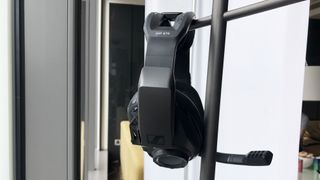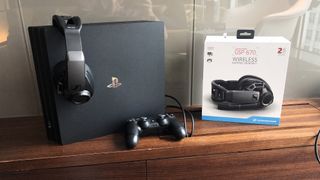Sennheiser is promising audiophile quality for its GSP 670 wireless gaming headset
After taking its latest headset for a test drive, I think Sennheiser might be onto something.

When we reviewed the Sennheiser GSP 600 just over a year ago, we were content. Coupled with a sweeping soundstage, its interchangeable earcups and cover plates made for a polished, fully realized gaming headset from Sennheiser right off the bat. Not even from the best gaming headsets of the time had we heard such a vast range of pulsating frequencies.
But the GSP 600 was flawed in more ways than one. For a wired gaming headset, its $219 price tag was laughable, and its fit was a little too tight for our liking. Enter the Sennheiser GSP 670. Perhaps a future addition to our best wireless gaming headset rankings, this new model is the first of its kind for Sennheiser. No longer held back by the limitations of a 3.5mm audio cable, the GSP 670 is capable of driving up to 20 hours of 7.1 surround sound over Bluetooth and up to 16 hours over GSA 70.
Yes, that means the Sennheiser GSP 670 packs its own low-latency wireless connection dongle in addition to supporting the more ubiquitous Bluetooth standard. So whether you want to link it up to your PC or your smartphone, you can do so with the simple flip of a switch. As for when the battery runs out, you can charge the GSP 670 while continuing to play your favorite games. Better yet, if all you want is two hours of consecutive play, you only have to plug it in for seven minutes.

At Computex 2019, I had the chance to try out the Sennheiser GSP 670 myself, and while I'm not reaching for my wallet to shell out $349 for a new pair of cans, I will say they sounded better than any purely gaming focused headset I've used to date. To anyone familiar with the masterful German sound engineering of Sennheiser, this should come as no surprise.
Behind its comfy leatherette — and still removable — ear-shaped pads are two custom-fit versions of the sound drivers found in its existing audiophile headphones. Sennheiser didn't specify which ones, but you can take a guess based on its pricing. Though I haven't spent much time listening to Sennheiser's high-end studio headphones, I assume the GSP 670 sounds more like the $400 HD 600 than the $1,700 HD 800 S. Not that I'm complaining.
Positioned as the "gaming for audiophiles" headset, the GSP 670 sounded just as crisp at the midrange during my brief Anthem demo as it did on the high and low end. In a rare change for a gaming headset, gunning down enemies didn't produce needlessly deep bass, and the orchestrated background music was subtle, as if carefully layered under the gameplay effects. Instead of relying on cheap gimmicks, Sennheiser is playing to its strengths.

In an effort to mitigate the aforementioned issues of comfort we experienced with the GSP 600 before it, a two-axis metal hinge system holds the GSP 670 together. Not only does this help improve its fit, but Sennheiser claims the headset will also last longer as a result. Whether it's because of the build quality, the subdued aesthetics or a combination of both, everything about the GSP 670 does feel premium. The hinge is no exception.
The biggest gaming news, reviews and hardware deals
Keep up to date with the most important stories and the best deals, as picked by the PC Gamer team.
Nor is the adjustable boom mic, which Sennheiser boasts is of "broadcast quality." As is common for gaming headsets these days, an algorithm does its best to remove background noise. More striking is the lack of a dedicated mic mute button. In its place, you can automatically mute the boom by retracting it back to the outside of the left cup. At least in my experience, this seemed an effective alternative to the physical inline controls I normally see on gaming-branded headsets.
To achieve its 7.1 virtualized surround sound, Sennheiser has developed its own Gaming Suite software for Windows. Other facets of the application include custom EQ curves, along with in-game testing for those curves, battery life monitoring, noise isolation adjustments and more. Upon receiving our review unit, we'll be sure to paint a more vivid picture of the GSP 670 software and hardware alike. In the meantime, you can look forward to its official release on July 1, 2019.
Most Popular

